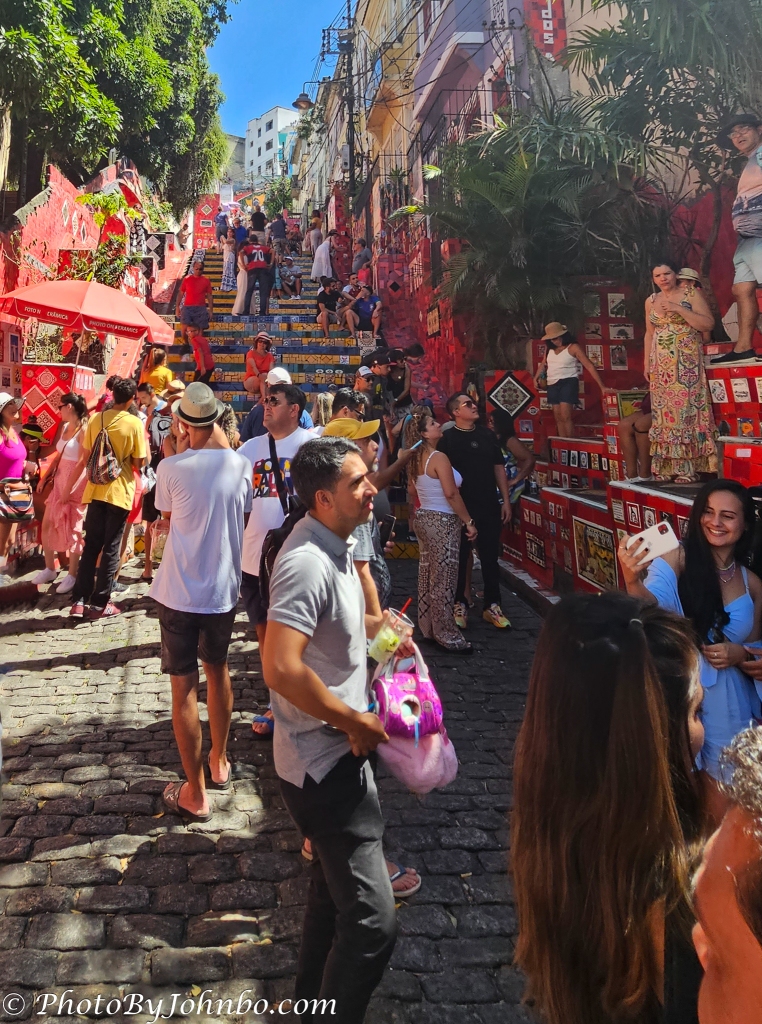Rio de Janeiro, Brazil.
The Selarón Steps, also known as Escadaria Selarón, are a well-known set of steps in Rio de Janeiro, Brazil. The run-down stairway was transformed into a work of art by Chilean-born artist Jorge Selarón, who began renovating the stairsteps in 1990 with tiles in the colors of Brazil (yellow, green, and blue) and his home country of Chile (red). Over the years, Selarón collected tiles from all over the world, and the steps eventually became a mosaic of over 2,000 tiles, many donated by tourists from over 60 countries.
The steps are located in the Lapa neighborhood of Rio, and they connect the lower neighborhood of Lapa with the upper neighborhood of Santa Teresa. As you can see from my photos here, the steps are a popular tourist destination. On the day we visited, it was third in the number of visitors, less crowded than Sugarloaf Mountain, and the most popular site, Christ the Redeemer. Since the area is so small, however, it actually seemed more crowded than Sugarloaf.
Selarón worked on the steps for over 20 years until his death in 2013. He considered the steps a “tribute to the Brazilian people,” and he said that he wanted them to symbolize peace and unity. I found a fascinating article on the web archive site here, referenced as a footnote in Selarón’s Wikipedia entry.
Selarón collected tiles from worldwide, including Brazil, Chile, Portugal, Italy, Spain, Greece, France, Japan, China, and the United States. He started the project by renovating the steps in front of his house, number 24, about halfway up the 215 steps. From there, he expanded the project to continue along Manuel Carneiro street/stairway, the steep connector between Joaquim Silva and Pinto Martins streets.
The image of a pregnant African woman is a theme of over 300 hand-painted tiles. Though not in the image I captured, in many of the tiles she is holding a fish. According to a web archive page reference that I found here, the pregnant African women helped fund his work on the steps. On that page, he noted, “I painted paintings to earn some money so that I would be able to continue my work. Since 1977, I have painted and drawn over 25,000 pregnant women, my choice of subject due to a past personal issue.”
He continued, “The tourists and travellers from all over the world who visit my work are very important, because they buy my paintings and postcards that enable me to continue my masterpiece – and they take my story with them to other lands. I always dream that each of them will send me a tile from their country to include in the stairway, a dream that I hope will become a reality.” His article ended with a premonition of sorts, “This crazy and unique dream will only end on the day of my death,” and signed Selarón
Tragically, he died under mysterious circumstances, his body found on the steps of his “tribute to the Brazilian people” with burn marks. Officially his death was recorded as a suicide. He was 65 years old.
John Steiner




Such vitality and joy in the colourful tiles, only to have such a tragic end.
So true, VJ!
Wow! What a burst of beautiful color after reviewing posts from my black and white challenge this week.
It is a colorful place, for sure!
😊
His work is beautiful, and how sad to die on his works. 😭
The steps remind me of some in San Francisco but with a very different story, both interesting and tragic. Thanks for sharing, John.
I will have to check on that story, Janet. I am not familiar with the steps in San Francisco.
https://thebolditalic.com/7-beautiful-mosaic-tiled-stairways-in-san-francisco-cf370cdbb627
Thanks!
You’re welcome. 🙂
Wow, bright colors! Such a sad ending of the tile works.
A very popular attraction!
When I visited Selarón Steps in Rio, there weren’t many people around, a policeman was at the bottom, but at the top a group of young men just waiting along a wall didn’t give me much confidence. Added to the tragic end of Selarón, probably murdered, I didn’t stay long. But the stairs are one of the best places in Rio, so fascinating to photograph too.
Interesting! On the day we were there, a murder would have no shortage of witnesses.